Have you ever asked the question why update your brand identity or what constitutes the business case? On one hand, having a top-performing brand is essential for high-performance marketing; on the other hand, as markets evolve, technologies emerge, and firms adjust their strategic intentions and go-to-market programs, the requirements for brand performance are subject to change.
We invited Laura Jones, CMO at Instacart, Stephen Root, VP Intuit Brand Marketing at Intuit, and Ricky Engelberg, CMO at Vistaprint, to the Marketers That Matter Forum held at Intuit’s Silicon Valley headquarters to discuss the critical topic of the impact of brand identity, and how they each navigated their recent brand transformation. Enjoy this special recap of the conversation.
You Can Find the MTM Visionaries Podcast On Apple, Spotify, Amazon, and more!
Brand Recognition
If we were to run a list of the most significant marketing innovations of the 20th century, somewhere near the top of the list, we would most certainly find the idea of the brand.
Google’s Ngram Viewer< provides some empirical proof for this assertion. This big data analyzer takes a huge sample of books – published across many decades (including the 19th and 20th centuries), in different languages, and representing different genres (e.g., fiction versus non-fiction) – and counts the word frequency of various terms and phases. In this way, we can see how words and names have ebbed and flowed in popularity through culture, business, and society.
Let’s look at the track record for the brand and its cognates:
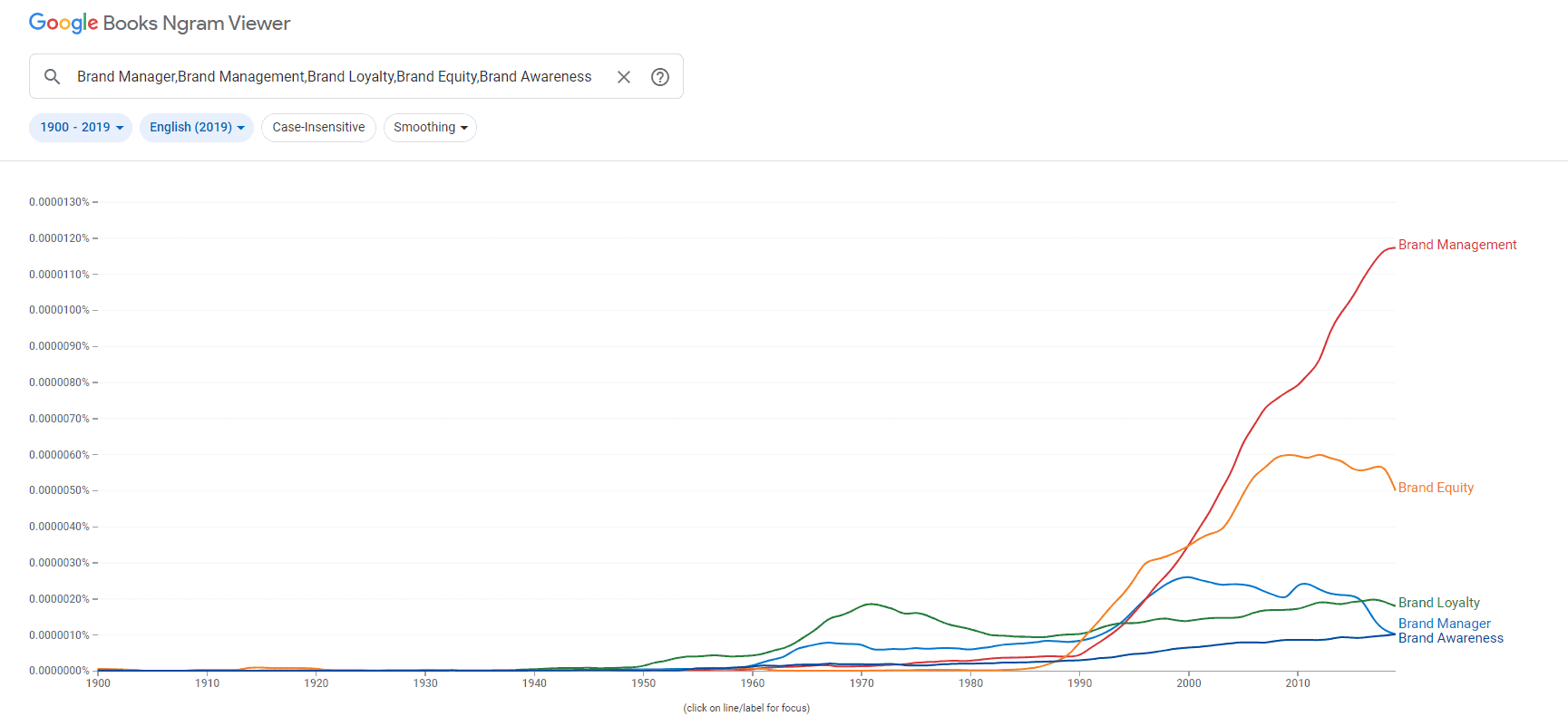
Google Ngram Viewer: “Brand Manager, Brand Management, Brand Loyalty, brand Equity, Brand Awareness”
Clearly, over the latter half of the 20th century, creating, maintaining, and building brand strength has been a major preoccupation of marketers of all stripes.
And why not? Brands amplify and focus communication. A strong brand stands out in crowded, competitive markets: positioned uniquely in the customer’s mind and typically commanding a price premium. A brand’s visibility and recognition can power new products and business lines. A strong and valuable brand can conjure up the magic of brand extensions or even launch new lines of business under the reliable shade of the vaunted brand umbrella.
In the early 20th century, the leader of the Quaker Oats Company, John Stuart, clearly understood that a branded offering could best unlock consumer loyalty. The value of the brand was, for him, preeminent:
“If this business were split up, I would give you the land and bricks and mortar, and I would take the brands and trademarks, and I would fare better than you.”
– John Stuart, ex-chairman of Quaker Oats
Brand consultancies, like Interbrand, BrandZ, and Brand Finance, have developed methodologies to peg the value of a brand, and not surprisingly, these intangible assets can climb into the hundreds of billions of dollars. Amazon, Apple, and Google are among the world’s most valuable brands. As Stuart accurately perceived so long ago, these brands represent a storehouse of value that rivals lofty market caps and physical assets on balance sheets.
Managing Brand Assets
While most marketers recognize the value of a strong brand, and these same marketers rely on brand identification systems to communicate with customers, channel partners, investors, employees, and other stakeholders, they must also keep a vigilant eye on the overall health of the brand. Brands are like other assets; their value can grow, plateau, or even erode.
Thus, many marketers and brand managers will periodically seek to refresh or renew brand identity and image. Sometimes these adjustments are minor and may even escape obvious detection; however, incremental changes and period updates can keep a brand image from getting frozen in time.
MTM Silicon Valley Forum: Brand Identity
In our recent San Francisco Forum, Marketers that Matter™ assembled its community to consider how leading firms and their top marketing talent face this complex set of issues related to maintaining brand health. On one hand, having a top-performing brand is essential for high-performance marketing. But on the other hand, as markets evolve, as technologies emerge, and as firms adjust their strategic intentions and go-to-market programs, the requirements for brand performance are subject to change.
On a day-to-day basis, brand identity systems do the heavy lifting of product marketing and corporate communications. Nevertheless, we still need to step back, on occasion, to audit the performance and strength of our brands. We must adjust (often on the fly) to disruptive events like new product introductions, mergers and acquisitions, competitive realignment, and changes that permeate the economic system and macro-operating environment.
Simply put, how do we position our brand – our corporate brand, our divisional identities, our branded product portfolios, our visual identity systems, and conventions – as the chief symbol of our identity at the cutting edge? How do we identify when the identity is starting to lag or represent circumstances beginning to fade or losing relevance?
We invited three leading companies – Instacart, Intuit, and Vistaprint – and their top marketers to a forum held at Intuit’s Silicon Valley headquarters.

Stephen Root, VP Intuit Brand Marketing, Intuit; Ricky Engelberg, CMO, Vista; Laura Jones, CMO, Instacart at the MTM Forum in Silicon Valley
Here were the essential questions that guided our discussions:
- Why update your brand identity? What constitutes the business case?
- What about timing? What provokes a refresh, a significant repositioning, or even a name change?
- How to update? Where to start? And at what pace do you proceed?
- What counts as success? How do you measure and ultimately evaluate the update?
Case Study #1
Instacart: Consolidating Brand Success

Laura Jones, CMO, Instacart
Instacart is an online grocery platform operating in North America. Instacart’s technology platform connects consumers with shoppers, who can provide same-day delivery and pickup services to bring fresh groceries and other essentials to people and households across the U.S. and Canada.
The COVID pandemic profoundly impacted Instacart’s trajectory of expansion and growth. The effect was immediate. About one year into the pandemic, Instacart CMO Laura Jones noted, “We saw five years of growth in a matter of five weeks” (Sorvino, Instacart survived Covid Chaos – but can it keep delivering after the pandemic? 2021). And that growth has scarcely diminished.
But the pandemic has driven many aspects of digital life deeper into the fabric of daily life, which most assuredly includes shopping and delivery of all sorts. As a result, Instacart has steadily partnered with more retail partners (beyond grocery) and some 5,500 CPG brands (King, Carrot Evolution: A new brand identity to reflect a new ambition 2022). This crush of business has allowed Instacart’s enterprise technology to advance and support some of the world’s biggest retail players, supporting their white-label websites, applications, and delivery solutions. Instacart is also helping minority-owned CPG brands grow with its Instacart Ads Initiative.
The Solution: The Carrot Evolved
As our MTM Forum unfolded, Laura discussed how this shifting landscape of opportunity placed a new set of needs and requirements on the Instacart brand. “The opportunity [we saw],” explained Laura, “was to take this product out of the realm of purely transactional, and bring it into the world of emotion, inspiration, and tap into some of that joy that we all feel when we walk into a grocery store and see this kind of sensorial overload of more products than you could ever consume…So, it was really two impetuses. One, just reflecting the growth of the business and the changing nature of the business…moving from the transactional to inspirational.”
Recognizing some element of “mismatch” between Instacart’s past and its future, brand strategists and designers seized on the carrot icon that was central to Instacart’s iconography and essentially transformed it to reflect the company’s evolution as grocery+. The carrot morphed from a static representation of food to a more dynamic indicator of choice, selection, and enjoyment.
Instacart Brand Logo (before)
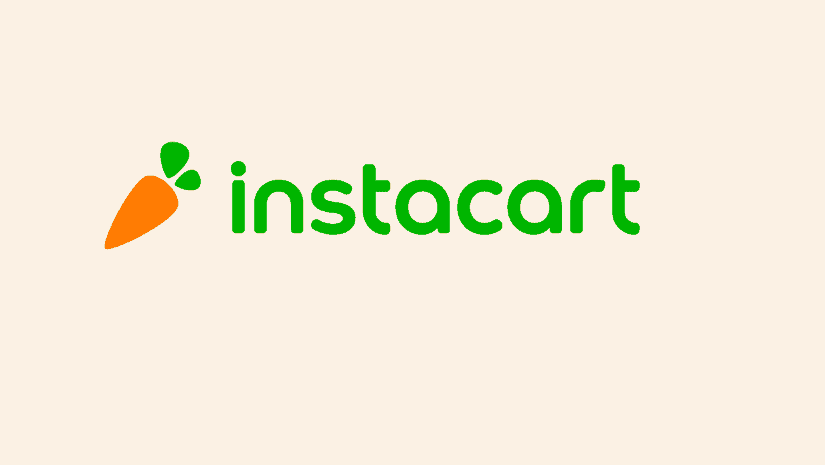
Instacart Brand Logo (after)
|
Carrot Evolution: A New Brand Identity to Reflect a New Brand Ambition |
||
|
Brand’s Directional Evolution |
From –> |
To |
|
Brand Essence |
Efficiency | Experience |
|
Brand Emotion |
Transactional |
Inspiration |
|
Brand Journey |
Shop |
Savor |
|
Brand Audience |
Instacart Consumer (and Shopper) |
Instacart Community (e.g., employees, entrepreneurs, retailers, brand partners) |
|
Brand Mantra |
“groceries delivered in an hour” |
“powering the way you shop so you can savor all of life” |
|
Brand Media |
Focused: online |
Expansive: Instacart app, advertising offerings, retail products, corporate website, social channels, paid media, events |
| Brand Identity | Legacy carrot; distinctive green and orange |
Refreshed visual identity with new logo, wordmark, typography, and new color palette grounded in food |
Case Study #2
Intuit: Bringing Brands into Balance

Stephen Root, VP Intuit Brand Marketing, Intuit
Intuit has witnessed amazing growth on the power of its blockbuster branded products – QuickBooks and TurboTax have dominated large swathes of the market: personal finance, accounting software for small and medium-sized businesses, and then, of course, tax preparation. Intuit’s growth has been further fueled by strategic acquisitions, including Mint, Credit Karma, and Mailchimp.
But here’s the basic brand-math question: Is the whole – which is to say, the corporate parent brand, Intuit – greater than the sum of its parts? Questions like these fall into that somewhat arcane area of branding philosophy known as brand architecture – and it gets complicated quickly (Gilman, What is Brand Architecture? 2022). Which is to be preferred? Branded house (e.g., BMW) or house of brands (P&G)? And the options quickly proliferate beyond those two options. We have endorsed-brand options like Courtyard by Marriott, linked names like Egg McMuffin and Nestea, and co-drivers like Adobe Photoshop, Gillette Mach 3, or HP DeskJet.
Such legacies of complicated naming conventions represent complex corporate histories or convoluted trails of mergers and acquisitions, divestitures, and spin-offs. And this history is something that deserves respect. Brand equity is sometimes slow to build, and thus managers often loathe withdrawing support or other symbolic signifiers.
But such loyalty to past successes can obscure the pathway to new opportunities in the form of emerging markets and new business platforms. Indeed, the market embrace of strong branded products can be the precursor of even bigger things coming down the road.
For example, few industries have been faster than the financial services industry in riding the wave of digitization and automation. Intuit has experienced this dramatic lift, but perversely as its branded products have become stronger and stronger, they found the purpose of the corporate brand grew less clear.
In our MTM forum, Stephen Root, VP Intuit Brand Marketing at Intuit, put it this way: “We really need[ed] Intuit to stand for something more than just a corporate brand.” Too many “people didn’t know Intuit… What are we as a company? … It’s really important because when we looked at our brand and overall positioning and logo, it didn’t fit with the direction in which we’re heading…”
It was this relative corporate identity vacuum – existing as it did alongside huge market opportunities – that convinced the executive and marketing teams that Intuit required a brand refresh. The need was clear: Intuit could benefit in many ways by providing greater clarity to that most vexing of corporate questions, what business are we actually in? And then, what business will we be competing in five years from now?
The Solution: Re-Introduce Intuit
Intuit needed to strike a balance between a past of strong products and a future of serving – even anticipating – its customers’ economic and business aspirations. Over the decades, Intuit had achieved remarkable expertise not only in software development and distribution but had, at the same time, carefully constructed a brand foundation in financial services and technology innovation that enabled its robust product pipeline and positioned the company to address a broad array of consumer and business needs: accounting and taxes, yes, but also spending, saving, checking, loans, insurance, marketing, payroll and more.
Strategically speaking, Intuit had, with its products and acquisitions, the capacity to provide consumers and small business access to a global financial technology platform company fully capable of “powering prosperity” – an apt characterization of Intuit’s larger strategic intention.
This brand refresh, now fully underway, not only gives new meaning and relevance to the company name to the next generation of Intuit users, but the brand mantra of “powering prosperity” places the customer at the center of this brand image and symbolism. Thus, in announcing its brand refresh in this video, we get a full portrayal of Intuit customers pursuing a broad range of activities and opportunities:
|
Re-Introduce Intuit |
||
|
Brand’s Directional Evolution |
From –> |
To |
|
Brand Logo |
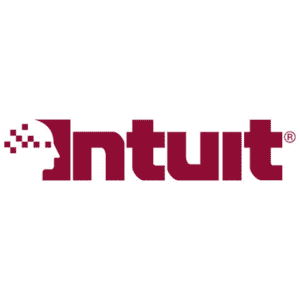 |

|
|
Brand Perception |
“Old and outdated” |
“A financial tech platform that powers prosperity for our customers and communities and is more human, modern, and sleek.” |
Case Study #3
Vistaprint: Building a Brand Bridge
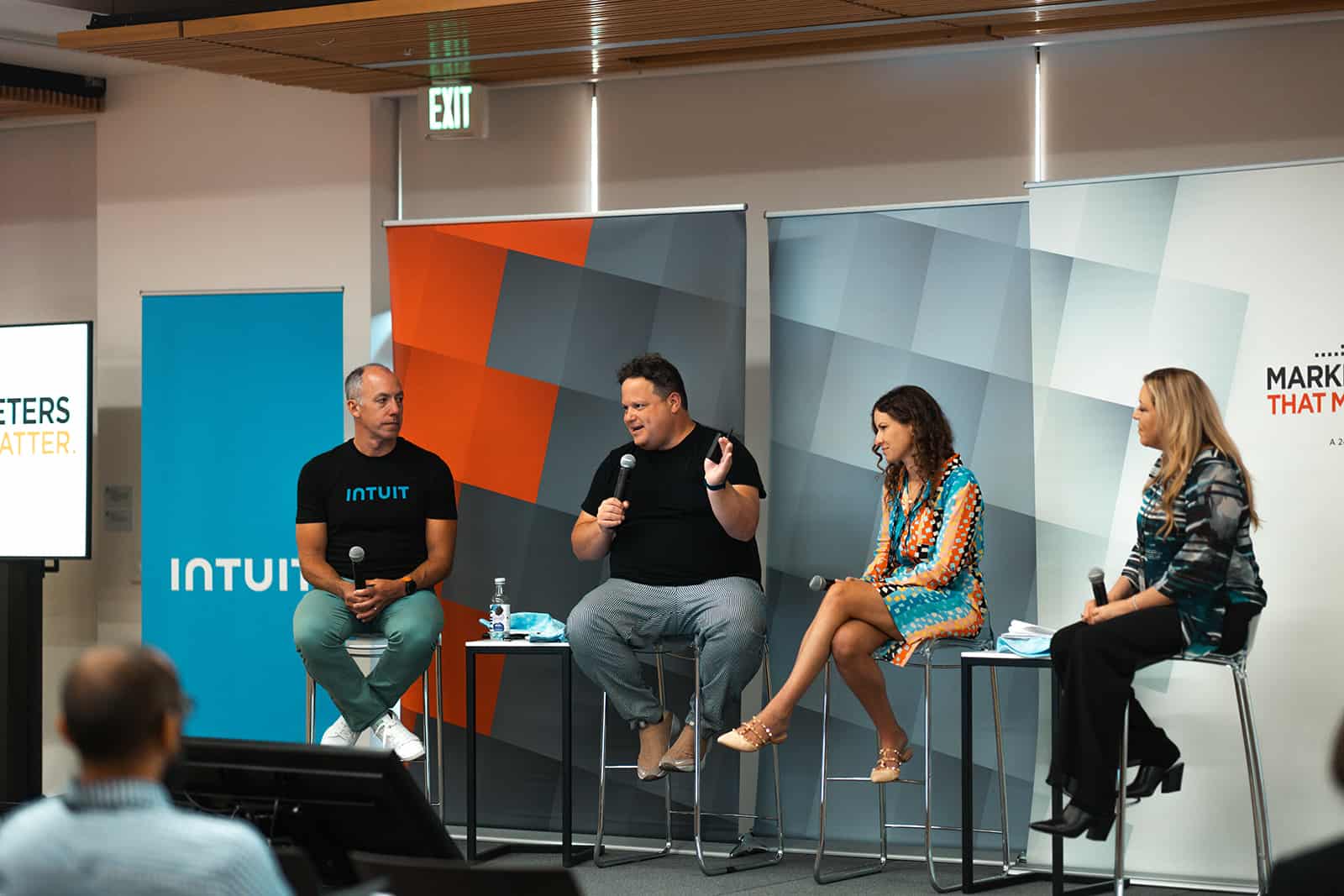
Ricky Engelberg, CMO at Vista
What’s in a name? Often quite a lot. When planners at Vistaprint put their brand under the microscope, here was what they found:
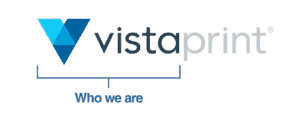
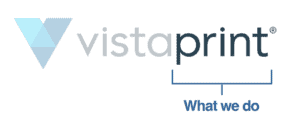
Ricky Engelberg, CMO at Vista, observed that Vistaprint’s business card printing was so visible, so big, and so firmly cemented in customer’s minds that it was effectively blocking their consideration of Vistaprint for other marketing and design services at which the company excelled. “There’s a massive opportunity for us to become the design and marketing partner for every small business.”
This, of course, is a delicate and challenging pivot for businesses to make. Chris Zook, a Bain & Company partner and author, popularized the notion of “Profit from the Core,” which asserted that building market strength in a well-defined core has, over time, remained a key source of competitive and advantage and the most favorable platform for the expansion of revenues and profits. The risk that some businesses run in the pursuit of growth is to abandon their core and stray from their reliable and proven core competencies and thereby miss the next wave of profitable growth.
The Solution: Vista’s Journey of Reconsideration
Engelberg knew that this “journey of reconsideration” would need to be navigated carefully, but it was a brand bridge that needed to be crossed. He sketched the brand bridge this way:
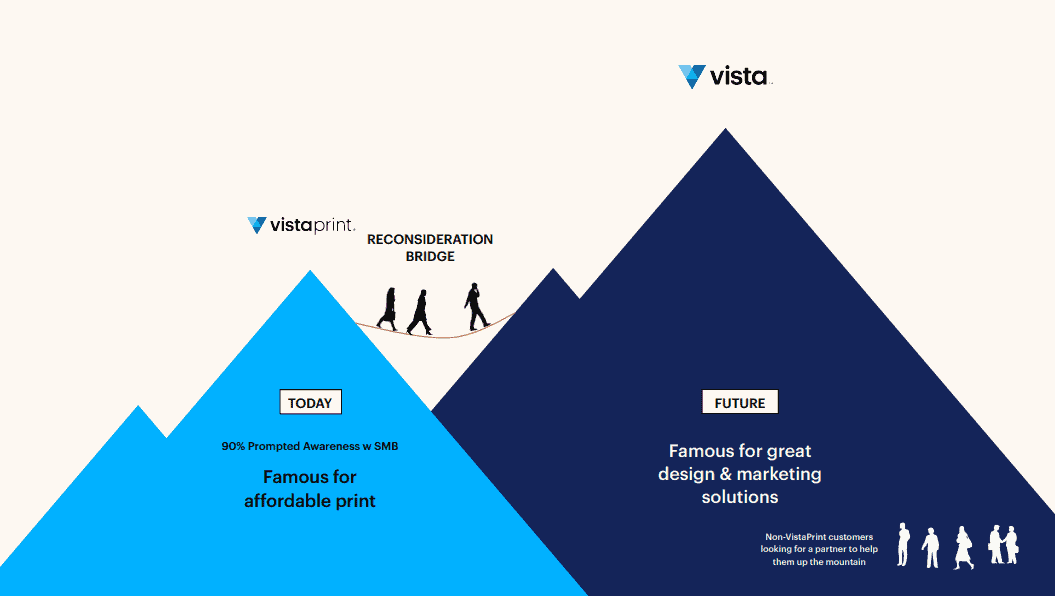
With 90% of Vistaprint’s prompted awareness currently focused on affordable print, Engelberg believes that Vistaprint must migrate toward just Vista. He stated, “We need to get all our existing customers across this Indiana Jones bridge in the middle of the New World, where we’re famous for great design and marketing solutions.” The migration is plausible when you consider this “brand billboard” that showcases the “houses of Vista:”
Ricky admits that “living this duality [can be] a little bit messy.” Vistaprint is not going away – it remains a signature service. Customer notions of what Vistaprint can print will continue to enlarge beyond business cards to include merchandise, promotional items, labels, and more.
“But if you only use Vistaprint, it’s tough to say that Vista exists. And so, it’s this constant balancing act of trying to evolve from a relationship standpoint.” There are also global communications that Vista is now using to position itself as offering not just print but also design and digital support. In this way, the brand bridge expands across the globe while also enlarging the brand’s potential. Their global communications now adapt to the focus market, from North America to France to Australia.
|
Vista’s Journey of Reconsideration |
||
| Brand’s Directional Evolution | From –> |
To |
| Brand Logo | Invisible |
Visible |
| Brand Perception | Printing Agency |
Design, Digital Support, and Marketing Solution Partner |
Brands For the Long Run: Takeaways
Are you getting the most from your brand? Here’s our brand health checklist, reflecting the lessons gleaned from our featured case studies. These include:
✅ Case Study #1) Pay attention to cultural trends and brand relevance and make necessary adaptations.
- Disruption in the form of new technologies, new competitors, and changing buyer behaviors and preferences require new business strategies and re-positioning. Brand identity is at the point of this spear.
- Though disruption often carries a negative connotation, rapid and often unexpected change that comes from this phenomenon can open important market opportunities. This was Instacart’s experience with the onset of the pandemic and its persistent and changing set of challenges. Seemingly overnight, Instacart has not just more grocery customers but a set of distinctive competencies, infrastructure advantages, and stress-tested technologies that could provide market-ready solutions to many business customers and operators outside of the grocery and food business.
- An updated brand identity will provide a communications platform that matches the dimensions of its formidable technology platform and delivery system. The brilliance in Instacart’s brand makeover is to be found in the incremental and credible expansion of its existing system of brand beliefs and attention-getting brand symbolism. The “new” get incorporated into the brand foundation without any attendant loss in the established brand equity that has steadily accrued to Instacart.
✅ Case Study # 2) Get all stakeholders on board and create brand identity alignment.
- Although brands principally identify one marketer’s offering as distinct from those of competitors in the mind of customers, we find in our case studies that brand identity is also important for a variety of other stakeholders, especially employees. Brand meaning offers guide rails for aligning with corporate purpose and the larger strategic picture. This is important for attracting and retaining talent and moving the marketing agenda forward.
- At one time, it may have been useful to think of Intuit as a software company competing against other software providers for narrow functional ascendency related to specific applications like tax and accounting. But peel back these highly successful product offerings, and you’ll uncover more enduring needs related to financial planning and control. Intuit’s strategy has tracked these customer requirements with rapidly advancing technologies to provide broader and more integrated solutions with added intelligence and superior customer experience. Success in software verticals has been morphing for some time into a financial technology platform that could harness a range of financial aspirations, whether at the personal, household, or organizational level. As a strategic orientation or intention, this represents a move of enormous significance for the firm’s growth trajectory, financial valuation, talent requirement, and other strategic drivers. While the brand and its symbolic significance are often of paramount importance to customers and target markets, it is also a communications tool that must be aimed at other stakeholders like employees, investors, and the media. Intuit – a corporate identifier and an umbrella brand – is stepping out of the shadows and onto the main stage.
✅ Case Study # 3) Monitor and audit your brand identity to maintain its value and relevance.
- A successful brand refresh will link its established heritage with new possibilities and opportunities.
- Vistaprint’s position as the go-to printer of business cards was preeminent. Entrepreneurs and small businesses found the print-at-website service convenient and accessible while offering great value. But these customers and their business needs ran broader and deeper than just print. And so, too, did Vista’s capabilities extend into providing a wide variety of marketing services that had now moved into design and digital. The “print” in the Vistaprint brand was not an effective bridge to the broader consideration they desired and would effectively drive more and more of the company’s revenues and profits for the foreseeable future. Implementation of this brand refresh will similarly require that close attention and consideration be given to the pace of change and the relative emphasis that brand communications will place on existing products and services versus new offerings.
💡 Build your own brand-health dashboard to measure brand health performance for accountability and optimization pre, during, and post-brand identity transformation.
- Be clear on the expected outcomes of a brand refresh or brand repositioning. Set clear timelines and goals from the beginning for anticipated results.
- The old business adage that we can’t manage what we can’t measure applies here. Thus, the MTM Forum on Brand Identity also featured breakout workshops with the presenters and participants in which prototype “Brand Dashboards” were conceptualized and outlined. These frameworks provided a brand blueprint for monitoring the brand performance and other key indices of brand health.
- What precisely do these dashboard measure? The number of potentially significant variables is quite large; thus, different brands are likely to require different kinds of dashboards with different aims. But brand dashboards must generally measure important brand indices across key market segments. Usually, these indices will range from brand awareness to brand beliefs to brand preference and, ultimately, brand loyalty.
- Market analytic scoreboards can be developed in which brand performance and penetration can be indexed across market segments that are variously defined on demographic, lifestyle, or industry category. Frequently dashboards will have interfaces that permit the analysis of the brand’s traction across the customer journey: awareness to consideration to intent to decision. This can isolate growth-stalling bottlenecks and accelerated flows precipitated by marketing action. Plug-ins incorporating media and advertising campaigns are useful interfaces as brand managers try to relate marketing resource allocations to market and brand responses.
- In general, these dashboards focus on three time periods: past, present, and future. The dashboard should look back to provide an accurate snapshot of the brand’s present health (e.g., brand differentiation, brand equity, reputation). The inputs that feed into the dashboard should ladder up to composite performance measures and flexible and addressable databases that can be queried or otherwise analyzed to measure current performance and analyze, diagnose, and understand it.
- Finally, build the dashboard on plausible input-output market-response models that allow the manager to run simulated market experiments and to stand up various “what-if” scenarios to provide the necessary decision support and alternative market forecasts.
The case studies that our MTM Forum offered reveal the central role that brands play in creating value and communicating that value in memorable and enduring ways. But the care and maintenance of brand identity need constant vigilance. Brands will at times lag behind the rush of business activities, new combinations, and shifting trends. But at other times brands will seek to pull the firm, its employees, its investors, and its customers into a promising future with new opportunities and possibilities.
Stay tuned as we aggregate all the insights from the Forum breakouts and upcoming MTM Marketing Boards into a collective playbook for brand marketers everywhere!
Stephen Root, VP Intuit Brand Marketing at Intuit: Stephen Root is a global marketer with a passion for connecting with consumers and building great brands. He has extensive experience in brand and communications strategy, customer acquisition and retention, and strategic planning. He is the VP of Brand, Marketing Strategy, and Planning for Intuit. Before his time at Intuit, he was involved in three international assignments, most recently in Melbourne, Australia while having also lived and worked in Singapore and Zurich, Switzerland.
Laura Jones, CMO at Instacart: Laura serves as the CMO at Instacart. In her role, Laura is responsible for shaping a cohesive brand, fueling the company’s growth, and scaling the marketing organization. Since joining in June 2021, Laura has led a comprehensive brand identity refresh, launched the company’s first-ever integrated brand campaign, built out its Creative Studio, and developed a full-funnel in-house media team. Previously, she led the Rides business and Masterbrand at Uber Technologies. Her work has been cited by national and global outlets including the New York Times, the Wall Street Journal, Forbes, Fast Company, Bloomberg, AdAge, AdWeek, Business Insider, Vogue, People Magazine, and Good Morning America, among others.
Ricky Engelberg, CMO at Vista: Ricky Engelberg is the Executive Vice President and Chief Marketing Officer at Vista, the marketing partner to millions of small businesses around the world. As CMO, Ricky oversees all Marketing, Customer Experience, and Digital Product focused on driving Vistaprint forward as the marketing partner for every small business owner. Ricky joined Vistaprint in September 2019, after almost two decades at Nike and Converse helping drive the creation of Nike+, the Nike+ Fuelband, and Connected Product.

